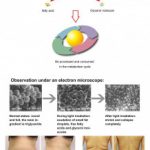Last Updated on 12 months by Francis
Light therapy has gained popularity as a non-invasive approach to rejuvenating the skin. This treatment involves exposing the skin to specific wavelengths of light, which are thought to stimulate collagen production and improve the appearance of fine lines, wrinkles, and other signs of aging. One of the primary questions people have about light therapy is whether or not it can actually tighten the skin. In this article, we will explore the evidence around this question and help you better understand whether light therapy is an effective way to tighten and firm your skin.
Contents
The Science Behind Light Therapy and Skin Tightening
Light therapy, also known as phototherapy, is a non-invasive treatment that uses specific wavelengths of light to improve various skin conditions. It has been widely used for acne treatment, but recent studies suggest that it may also be beneficial for skin tightening.
The skin has several layers, including the epidermis, dermis, and subcutaneous tissue. The dermis contains collagen and elastin fibers, which provide structural support and elasticity to the skin. As we age, the production of collagen and elastin slows down, leading to the appearance of wrinkles, fine lines, and sagging skin.
Light therapy works by stimulating the production of collagen and elastin in the skin. When specific wavelengths of light penetrate the skin, they activate cellular processes that lead to the production of these proteins. This, in turn, leads to firmer, tighter, and more youthful-looking skin.
Red Light Therapy
Red light therapy is a popular form of light therapy that is often used for skin tightening. It uses red light wavelengths that penetrate the skin and stimulate collagen production. This helps to reduce the appearance of fine lines and wrinkles, as well as improve skin texture and tone.
Near-Infrared Light Therapy
Near-infrared light therapy is another form of light therapy that has been found to be effective for skin tightening. It uses near-infrared light wavelengths that penetrate deeper into the skin than red light, reaching the subcutaneous tissue. This can help to stimulate the production of collagen and elastin in the deeper layers of the skin, leading to more significant skin tightening.
The Benefits of Light Therapy for Skin Tightening
Light therapy has numerous benefits for skin tightening, including:
- Non-invasive: Light therapy is a non-invasive treatment that does not require any surgical incisions or injections.
- Safe: Light therapy is generally considered safe, with few side effects.
- No downtime: Unlike surgical procedures, light therapy does not require any downtime. Patients can resume their normal activities immediately after treatment.
- Long-lasting results: Light therapy can provide long-lasting results, with some patients experiencing skin tightening effects for up to six months after treatment.
Light therapy can be an effective, safe, and non-invasive treatment for skin tightening. It works by stimulating collagen and elastin production in the skin, which can result in firmer, tighter and more youthful-looking skin. Red light therapy and near-infrared light therapy are both popular forms of light therapy used for skin tightening. However, light therapy may not be effective for all patients, and multiple sessions may be required. Therefore, it is crucial to consult with a professional, follow the recommended treatment schedule, take care of your skin, and maintain a healthy lifestyle to get the most out of light therapy for skin tightening.
The Limitations of Light Therapy for Skin Tightening
While light therapy has many benefits for skin tightening, it also has some limitations:
- Limited effectiveness: Light therapy may not be effective for all patients, and some may only experience mild skin tightening effects.
- Multiple sessions required: To achieve optimal results, multiple light therapy sessions may be required.
- Maintenance required: Maintenance sessions may be necessary to maintain the skin tightening effects of light therapy.
Key takeaway: Light therapy, particularly red and near-infrared light therapy, can be effective for skin tightening by stimulating the production of collagen and elastin in the skin. It is a non-invasive and safe treatment with no downtime and long-lasting results, but may require multiple sessions and maintenance. To get the most out of light therapy for skin tightening, it is crucial to consult with a professional, follow the treatment schedule, take care of your skin, and maintain a healthy lifestyle.
How to Get the Most Out of Light Therapy for Skin Tightening
To get the most out of light therapy for skin tightening, it is essential to follow some tips:
- Consult with a professional: Before undergoing light therapy for skin tightening, it is crucial to consult with a professional to determine if it is the right treatment for you.
- Follow the treatment schedule: To achieve optimal results, it is essential to follow the treatment schedule recommended by the professional.
- Take care of your skin: After undergoing light therapy for skin tightening, it is essential to take care of your skin by using sunscreen, avoiding harsh chemicals, and moisturizing regularly.
- Maintain a healthy lifestyle: Maintaining a healthy lifestyle, including a balanced diet, regular exercise, and stress management, can help to enhance the skin tightening effects of light therapy.
FAQs – Does Light Therapy Tighten Skin?
What is light therapy?
Light therapy, also known as phototherapy or LED therapy, is a non-invasive treatment that uses specific wavelengths of light to promote healing and rejuvenation in the skin. Different light wavelengths are used to target specific skin concerns, such as acne, wrinkles, and hyperpigmentation.
How does light therapy tighten skin?
Light therapy can stimulate the production of collagen and elastin, which are responsible for the firmness and elasticity of the skin. As we age, the production of these proteins decreases, leading to sagging and wrinkled skin. By targeting specific wavelengths of light to penetrate deep into the skin, light therapy can help stimulate the production of collagen and elastin, resulting in tighter, firmer skin.
What are the different types of light therapy?
There are several types of light therapy that target different skin concerns. Red light therapy promotes collagen production and is best for reducing fine lines and wrinkles. Blue light therapy targets bacteria that causes acne, while green light therapy can improve skin tone and reduce hyperpigmentation. Some devices also offer a combination of these different wavelengths for a more comprehensive treatment.
Is light therapy safe?
Yes, light therapy is considered a safe and non-invasive treatment. It does not involve any injections or surgery, making it a great alternative to more invasive procedures. However, it’s important to follow the manufacturer’s instructions carefully and use the device as directed. It’s also important to protect your eyes during treatment as some devices emit bright light.
How long does it take to see results from light therapy?
Results can vary depending on the individual and the skin concern being treated. Some people may see results after just a few sessions, while others may take longer. Consistency is key when it comes to light therapy, so it’s important to use the device as directed and stick to a regular treatment schedule to get the best results.
Can light therapy replace other skin tightening treatments?
While light therapy can be effective in tightening and rejuvenating the skin, it may not be able to replace more invasive procedures, such as facelifts or laser resurfacing. However, it can be a great alternative for those who want to avoid surgery or who are looking for a more affordable and non-invasive option. It’s always best to consult with a dermatologist or skincare professional to determine the best treatment plan for your individual needs.







